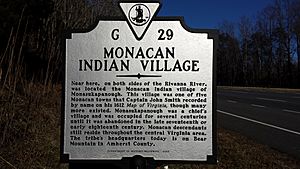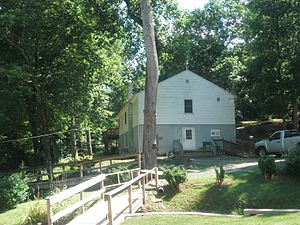Monacan Indian Nation facts for kids
| Total population | |
|---|---|
| Enrolled members 2000 | |
| Regions with significant populations | |
| Virginia, West Virginia, Maryland, Ohio | |
| Languages | |
| English, formerly Tutelo | |
| Related ethnic groups | |
| Tutelo, Occaneechi, Manahoac, other eastern Siouan tribes |
The Monacan Indian Nation is a group of Native American people. They are one of eleven tribes officially recognized by the state of Virginia. In 2018, the United States Congress also gave them federal recognition. This means the U.S. government officially recognizes them as a Native American tribe.
For a long time, the Monacan people faced many challenges. They lost land, experienced warfare, and dealt with discrimination. Some people thought they were no longer "Indians." But the Monacan people worked hard to keep their culture alive and strong.
Today, most Monacan people live in their traditional homeland in Virginia's Piedmont region. This is especially true in Amherst County, near Lynchburg. As of 2018, there are about 2,000 Monacan members. Some Monacan groups also live in West Virginia, Maryland, Tennessee, and Ohio.
The first time European settlers wrote about the Monacan nation was when the Jamestown colonists arrived in colonial Virginia. The Monacan people spoke a Siouan language, but it is no longer spoken today. They are related to other Siouan-speaking tribes in the area, like the Tutelo, Saponi, and Occaneechi.
Contents
Monacan History: The 1600s

When settlers from Jamestown explored the James River in 1607, they learned about the Monacan people. The Monacan, along with their allies the Manahoac to the north, controlled the Piedmont area. This land was between the Fall Line (where Richmond is today) and the Blue Ridge Mountains.
The Monacan were rivals of the Powhatan confederacy. The Powhatan were a group of thirty Algonquian-speaking tribes. They controlled the Tidewater and coastal plain. The Powhatan leader, Chief Powhatan's son Parahunt, told Captain Christopher Newport not to go past the James River falls into Monacan land.
Exploring Monacan Territory
However, Newport decided to explore Monacan country in 1608. During a 40-mile march, the settlers found two Monacan towns. They recorded their names as Massinacak and Mowhemenchough. Unlike the Powhatan, who welcomed the settlers, the Monacan mostly ignored them. They continued with their daily lives. The settlers captured the Monacan chief and made him guide them.
On November 26, 1608, a member of Newport's group, Peter Wynne, wrote a letter. He said some people thought the Monacan language sounded like "Welch" (Welsh). Wynne spoke Welsh, and Newport asked him to be an interpreter. But the language was not Welsh, and Wynne could not understand it.
Mowhemencho, the Monacan nation's easternmost town, was in what is now Powhatan County. Massinacak was near Goochland. The Monacan capital was Rassawek. It was located where the upper James and Rivanna rivers meet.
Other related groups lived nearby. The Monahassanugh (later called the Tutelo) lived near Wingina. The Monasukapanough (later called the Saponi) lived near Charlottesville. All these groups were closely related to the Siouan Manahoac to the north.
Conflicts and Alliances
In 1656, several hundred Nahyssan, Mahock, and Rechahecrians camped near the James falls. These groups may have included the Erie from Pennsylvania. They threatened both the Powhatan tribes and the settlers. A combined force of Powhatan and settlers tried to remove them. The Pamunkey chief Totopotomoi was killed in the battle. The Monacan and Erie tribes had a history of trading, especially for copper.
The Monacan towns of Mowhemencho and Mahock were still active in 1670. John Lederer and Major Harris visited them and saw that the men had muskets. Lederer wrote that the Monacan believed they had settled in the area 400 years earlier. They said they were driven from the northwest by an enemy. They found the Doeg people living there and eventually took over the land. The Monacan also taught the Doeg how to grow corn.
Lederer also wrote down another Monacan story. They believed that all people came from four women: Pash, Sepoy, Askarin, and Maraskarin. Because of this, they divided people into four tribes, named after these women.
At the time of Lederer's visit, the tribe had about 30 warriors. Their total population was perhaps 100 people. Lederer also noted the towns of Sapon and Pintahae on the Staunton River. Another explorer, Batts, recorded the latter town as Hanahaskie in 1671. This was likely a Nahyssan village. Around 1675, the Nahyssan settled on an island where the Stanton and Dan rivers meet. This was upriver from the Occaneechi people.
In 1677, the Monacan chief Surenough signed the Treaty of Middle Plantation. This treaty followed Bacon's Rebellion. In 1684, Virginian settlers and the Pamunkey met the Monacan and Manahoac on the Upper Mattaponi and North Anna rivers.
Moving Away from Settlers
By 1699, the Monacan people had left their original homeland. They moved further away because Europeans were taking over their land. The Virginian House of Burgesses gave much of the former Monacan land to French Huguenot refugees. These refugees settled on both sides of the James River in 1700 and 1701. They were first promised land at Jamestown. But the Virginian colonial government made them settle above the falls. In Goochland County, they started the villages of Manakin and Sabot, now known as Manakin-Sabot, Virginia.
A few Monacan people stayed in the area until 1702. But most of the tribe joined with the Nahyssan and other related Virginia Siouan tribes. These groups became known as the Tutelo-Saponi. Under this name, the tribe moved to North Carolina in 1702. Then they returned to Virginia, settling at Fort Christanna in 1714.
Later, they moved north to join the Iroquois near the Great Lakes for protection. They were noted in Pennsylvania by 1740 and in western New York by 1753. There, they joined the Cayuga. They fought with the Cayuga and the British against the Patriots during the American Revolutionary War. After the war, the Monacan went with the Iroquois to Canada. They settled at the Six Nation Reserve in Ontario. Their settlement of Tutelo Heights was noted in 1779. By the early 1900s, many of their descendants in Ontario had married into the Cayuga tribe.
Smaller groups are believed to have separated in North Carolina and other parts of Virginia.
Modern Monacan Nation: Origins and Recognition
After Peter Wynne's trip in 1608, some people wondered if the Monacan were "Welsh Indians." This was a myth about Welsh explorers coming to America long ago. Historians have found no proof for this idea. The Monacan language was part of the Siouan language family.
In the early 1830s, William Johns, an ancestor of some Monacan people today, bought land on Bear Mountain. This was for a settlement for his family. In 1850, the census recorded 29 families living there.
Over time, Native Americans in Virginia married people of European and African American descent. Some white people wrongly thought this meant they were no longer "Indians." But the Monacan people kept their culture and community strong.
Challenges to Identity
In 1924, Virginia passed the Racial Integrity Act. This law said people could only be classified as black or white. It also used the "one-drop rule," meaning if a person had any known African ancestry, they were classified as black. The head of the vital records department forced some families, who had always been recorded as Indian, to be reclassified as black. This law ignored how people saw themselves and their culture. It also messed up historical records. But American Indians in Virginia kept their culture and community. They reorganized in the 1900s to get back their recognition as Native American peoples.
When Monacan ancestors joined the U.S. military for the world wars, they refused to be classified as "colored." This was the classification Virginia tried to force on them.
The Episcopal Church ran a primary school for the community's children at Bear Mountain. It was called the Bear Mountain Indian Mission School. There was no high school available for them. In 1963, Amherst County suggested building a new school for the mission community. But the idea was voted down. So, 23 students asked to transfer to public schools. The state approved their requests, and the mission school closed.
Official Recognition as Native Americans
In the early 1980s, a local doctor named Peter Houck wrote a book. He suggested that the free people of color in the region before the Civil War were partly descendants of the Monacan tribe. Before his book, most people in that area who claimed Native American ancestry identified as Cherokee. Many local families still claim Cherokee ancestry instead of Monacan.
In 1988, the Monacan Tribe officially formed as a nonprofit group. In 1989, the state of Virginia officially recognized the tribe. Other tribes recognized by the state include the Chickahominy, Eastern Chickahominy, Mattaponi, Nansemond, Pamunkey, Rappahannock, Upper Mattaponi, Patawomeck, Nottoway, and Cheroenhaka (Nottoway) tribes.
On January 30, 2018, the Monacan Nation and five other tribes in Virginia received federal recognition. This happened when Congress passed the Thomasina E. Jordan Indian Tribes of Virginia Federal Recognition Act of 2017. President Trump signed the bill into law.
Monacan Celebrations Today
Today, the Monacan Tribe holds a yearly powwow in May. They also have a homecoming celebration in October. A model of an ancient Monacan village has been built at Natural Bridge (Virginia) State Park in Rockbridge County.
|


